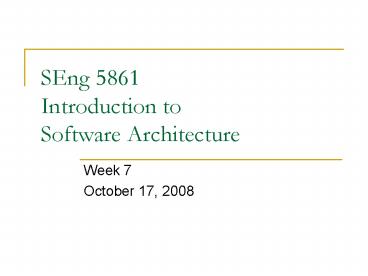SEng 5861 Introduction to Software Architecture PowerPoint PPT Presentation
1 / 28
Title: SEng 5861 Introduction to Software Architecture
1
SEng 5861Introduction to Software Architecture
- Week 7
- October 17, 2008
2
Agenda
- ATAM Analysis Method
- ATAM Exercise
- CBAM Analysis Method
3
The ATAM
- Architecture Tradeoff Analysis Method
- A thorough and comprehensive way to evaluate a
software architecture - This is hard
- Large systems are very complicated
- Evaluation needs to compare business goals and
technical decisions - Careful management of an evaluation process is
needed to consider multiple stakeholders in a
review format
4
Participants in the ATAM
- Three basic groups
- The evaluation team 4-5 people
- Project decision makers PM, customer, architect
- Architecture stakeholders recommend 12-15
5
Outputs
- A concise presentation of the architecture
- Defined business goals
- Quality requirements via a collection of
scenarios - Mapping of architectural decisions to quality
requirements - A set of risks and nonrisks
- A set of risk themes
6
Sensitivity and Trade-offs
- Sensitivity point
- Identifies one or more components critical for
achieving a particular quality attribute - Trade-off point
- Property that affects more than one attribute and
is a sensitivity point for more than one attribute
7
Risks and Non-Risks
- Risks
- Potentially problematic architectural decision
- Documenting Identify decision quality attr
- Non-risks
- Good decisions that rely on assumptions in the
architecture - Should be recorded so assumptions dont change
8
Phases
- Phase 0 partnership and preparation
- Phase 1 and 2 evaluation
- Phase 1 has 6 steps with smaller group
- Phase 2 has 3 steps with all stakeholders
- Phase 3 follow-up via written report
9
Phase 1
- Present the ATAM process
- Present the business drivers
- Present the architecture
- Identify architecture approaches
- Generate quality attribute tree
- Table 11.5
- Analyze the architectural approaches
10
QA Utility Tree
11
Group Exercise
- Write out high-level architecture and
architectural approaches - Generate a Quality Attribute Utility Tree for
your Architecture
12
Phase 2
- Hiatus
- Brainstorm and prioritize scenarios
- Table 11.6
- Analyze the architectural approaches
- Present results
13
Brainstormed Scenarios
14
Prioritization
- Each group member gets a number of votes equal to
30 of the number of remaining scenarios - Can vote anyway that you want
- Vote publicly
15
Types of Scenarios
- Use Cases
- Expected operation
- Growth
- Anticipated changes
- Exploratory
- Stress the system
16
Group Exercise
- Cross-group Scenario Generation
17
Group Exercise Details
- Present your architecture (briefly) to your
paired team - Present your quality attribute utility tree, too
- Everyone (combined groups) brainstorms quality
attribute scenarios - Combine and prioritize scenarios
- Role reverse and do 2nd system
18
Benefits of the ATAM
- Gets stakeholders together
- Forces specific quality goals
- Prioritization of conflicting goals
- Forces clear architecture presentation
- Improved quality of architectural docs
- Uncovers reuse opportunities
- Improved practices
19
ATAM Summary
- Not an evaluation of requirements
- Not a code evaluation
- Does not include actual system testing
- Not precise, but identifies possible risk areas
within the architecture - Actual practice amazement that so many risks
can be found in such a short time.
20
CBAM
21
The CBAM
- The biggest tradeoffs in large, complex systems
usually have to do with economics. - How should an organization invest its resources
to maximize gain and minimize risk? - Economics includes cost to build, but also the
benefits that an architecture delivers.
22
Decision-Making Context
- Begins with the ATAM results
- Adds in costs and benefits associated with the
architecture decisions - The stakeholders decide if they should
- Use redundant hardware failover load balance
- Save cost on this project, invest in another
- Provides a framework for making decisions
- Helps clarify ROI the ratio of benefit to cost
23
Utility
- Definition the benefit gained by system
stakeholders - Variation set of ATAM scenarios by varying the
value of the responses, which gives a
utility-response curve - Examples in Figure 12.2
24
Practical Curves
- Use only 5 data points
- 4 values independent of architectural strategy
- Best-case (0.1 sec RT is instantaneous to a
person, so .03 doesnt matter) 100 - Worst-case (minimum requirement) 0
- Current (relative to Best Worst) x
- Desired (relative to Best Worst) y
- Generate the curves for all scenarios
25
Architectural Strategies
- How do you move from the current quality
attribute response level to the desired or
best-case level? - What would be a strategy for
- increasing system response time?
- Increasing capacity?
- Fifth data point derive expected value of the
new response utility is interpolation of
original 4 values - Watch out for side effects
26
CBAM Example
27
Monte Carlo Simulation
- Example Crystal Ball (Oracle)
- Use with network diagram where each node has a
certain probability of some outcome - Example application
- Performance analysis
- Expected utility
- Scheduling
28
Discussion on Analysis Methods and Wrap-up

